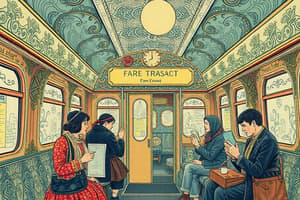Podcast
Questions and Answers
What is the primary purpose of fare in transportation services?
What is the primary purpose of fare in transportation services?
- To provide discounts to passengers
- To encourage competition among transport services
- To cover operational costs and generate revenue (correct)
- To facilitate advertising for transport agencies
Which of the following is NOT a type of fare structure?
Which of the following is NOT a type of fare structure?
- Seasonal fare (correct)
- Single fare
- Zonal fare
- Multi-journey fare
What factor does NOT influence fare setting in transportation?
What factor does NOT influence fare setting in transportation?
- Government regulations
- Passenger loyalty programs (correct)
- Operational costs
- Demand during peak hours
How does automated fare collection (AFC) improve fare processes?
How does automated fare collection (AFC) improve fare processes?
Which of these payment methods is commonly associated with modern fare collection systems?
Which of these payment methods is commonly associated with modern fare collection systems?
What strategy can be implemented to encourage ridership during off-peak times?
What strategy can be implemented to encourage ridership during off-peak times?
Which of the following is a major concern for fare structure design?
Which of the following is a major concern for fare structure design?
What does a tiered fare system primarily aim to encourage?
What does a tiered fare system primarily aim to encourage?
Flashcards
What is fare?
What is fare?
The price charged for transportation services, like buses, trains, or subways, usually involving various payment methods, such as cash, cards, or mobile apps.
What are types of fare structures?
What are types of fare structures?
Different ways to calculate fares based on factors like distance, time of travel, or frequency of use. Examples include single fares, zonal fares, and multi-journey fares.
How are fares collected?
How are fares collected?
Traditional methods using coin-operated meters, ticket vending machines, and ticket inspectors. Modern systems often use automated fare collection (AFC) technologies like contactless payments, smart cards, and mobile apps.
What influences fare setting?
What influences fare setting?
Signup and view all the flashcards
What are the characteristics of off-peak fares?
What are the characteristics of off-peak fares?
Signup and view all the flashcards
What is a tiered fare system?
What is a tiered fare system?
Signup and view all the flashcards
How are fares differentiated based on peak vs. off-peak hours?
How are fares differentiated based on peak vs. off-peak hours?
Signup and view all the flashcards
How should fare structures be considered?
How should fare structures be considered?
Signup and view all the flashcards
Study Notes
Definition and Types of Fare
- Fare is the price for transportation, often in public transit or travel services.
- Payment methods include cash, credit cards, and mobile ticketing.
- Fare structures vary: single fares, zonal fares, and multi-journey fares, based on distance, time, or travel frequency.
- Fare prices can change due to transport type (bus, train, subway), distance, time of day, and promotions/discounts.
- Different fare classes exist for passengers (adult, child, senior).
Fare Collection Mechanisms
- Traditional methods include coin-operated meters, ticket vending machines, and ticket inspectors.
- Modern methods use automated fare collection (AFC): contactless payment, smart cards, and mobile apps.
- AFC systems scan tickets/cards, recording transactions for accounting and security.
- Computerized systems boost efficiency and security compared to manual methods.
- Mobile ticketing lets passengers buy/validate fares on smartphones, reducing physical tickets/cards.
Factors Influencing Fare Setting
- Operational costs (fuel, labor, maintenance, administration) impact fares.
- Peak-hour demand influences pricing strategies.
- Government regulations and subsidies affect transportation costs and fares.
- Competition from other transport modes (bike-shares, carpooling) impacts pricing.
- Fare structure balances passenger and service provider needs for efficiency and usage.
Fare Structure Considerations
- Pricing strategies encourage ridership during off-peak hours.
- Tiered systems with multi-journey discounts promote repeat use.
- Fares adjust to peak/off-peak travel demand to meet service needs.
- Differential pricing for students/seniors increases participation, social inclusion, and acknowledges specific needs.
- Dynamic fare adjustments respond to demand fluctuations and price constraints.
Impact of Fare Policies
- Optimal fares encourage efficient transport infrastructure use.
- Differential fare structures reduce peak-hour overcrowding.
- Well-designed fare systems create efficient and sustainable public transport.
- Fares affect the financial stability of transport providers.
- Pricing and service offerings combine to encourage efficient system use and ridership.
Studying That Suits You
Use AI to generate personalized quizzes and flashcards to suit your learning preferences.




